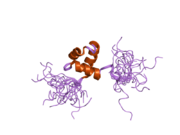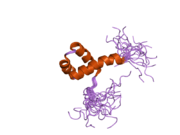CDC5L
| CDC5L | |||||||||||||||||||||||||||||||||||||||||||||||||||
|---|---|---|---|---|---|---|---|---|---|---|---|---|---|---|---|---|---|---|---|---|---|---|---|---|---|---|---|---|---|---|---|---|---|---|---|---|---|---|---|---|---|---|---|---|---|---|---|---|---|---|---|
 | |||||||||||||||||||||||||||||||||||||||||||||||||||
| |||||||||||||||||||||||||||||||||||||||||||||||||||
| Identifiers | |||||||||||||||||||||||||||||||||||||||||||||||||||
| Aliases | CDC5L, CDC5, CDC5-LIKE, CEF1, PCDC5RP, dJ319D22.1, cell division cycle 5 like | ||||||||||||||||||||||||||||||||||||||||||||||||||
| External IDs | OMIM: 602868; MGI: 1918952; HomoloGene: 13291; GeneCards: CDC5L; OMA:CDC5L - orthologs | ||||||||||||||||||||||||||||||||||||||||||||||||||
| |||||||||||||||||||||||||||||||||||||||||||||||||||
| |||||||||||||||||||||||||||||||||||||||||||||||||||
| |||||||||||||||||||||||||||||||||||||||||||||||||||
| |||||||||||||||||||||||||||||||||||||||||||||||||||
| |||||||||||||||||||||||||||||||||||||||||||||||||||
| Wikidata | |||||||||||||||||||||||||||||||||||||||||||||||||||
| |||||||||||||||||||||||||||||||||||||||||||||||||||
Cell division cycle 5-like protein is a protein that in humans is encoded by the CDC5L gene.[5][6][7]
Function
The protein encoded by this gene shares a significant similarity with Schizosaccharomyces pombe cdc5 gene product, which is a cell cycle regulator important for G2/M transition. This protein has been demonstrated to act as a positive regulator of cell cycle G2/M progression. It was also found to be an essential component of a non-snRNA spliceosome, which contains at least five additional protein factors and is required for the second catalytic step of pre-mRNA splicing.[7]
Interactions
CDC5L has been shown to interact with:
- ASF/SF2,[8]
- BZW1,[8]
- CWC15,[8]
- DNA-PKcs,[8]
- DYNC1H1,[8]
- GCN1L1,[8]
- HSPA8,[8]
- ILF2,[8]
- PLRG1,[8][9][10][11]
- PPM1D,[8]
- PPP1CA,[8]
- PRPF19,[8]
- RBMX[8] and
- RPL12,[8]
- RPL13,[8]
- RPS16,[8]
- RPS25,[8]
- SF3A1,[8]
- SF3B1,[8]
- SF3B2,[8]
- SF3B4,[8]
- SFPQ,[8]
- SFRS2,[8]
- SNRPA1,[8]
- SNRPD3,[8]
- SRRM1,[8]
- Small nuclear ribonucleoprotein D1,[8]
- Small nuclear ribonucleoprotein D2,[8]
- Small nuclear ribonucleoprotein polypeptide A,[8]
- TOP2A,[8] and
- TTF2.[12]
See also
References
- ^ a b c GRCh38: Ensembl release 89: ENSG00000096401 – Ensembl, May 2017
- ^ a b c GRCm38: Ensembl release 89: ENSMUSG00000023932 – Ensembl, May 2017
- ^ "Human PubMed Reference:". National Center for Biotechnology Information, U.S. National Library of Medicine.
- ^ "Mouse PubMed Reference:". National Center for Biotechnology Information, U.S. National Library of Medicine.
- ^ Groenen PM, Vanderlinden G, Devriendt K, Fryns JP, Van de Ven WJ (Apr 1998). "Rearrangement of the human CDC5L gene by a t(6;19)(p21;q13.1) in a patient with multicystic renal dysplasia". Genomics. 49 (2): 218–29. doi:10.1006/geno.1998.5254. PMID 9598309.
- ^ Bernstein HS, Coughlin SR (Feb 1997). "Pombe Cdc5-related protein. A putative human transcription factor implicated in mitogen-activated signaling". The Journal of Biological Chemistry. 272 (9): 5833–7. doi:10.1074/jbc.272.9.5833. PMID 9038199.
- ^ a b "Entrez Gene: CDC5L CDC5 cell division cycle 5-like (S. pombe)".
- ^ a b c d e f g h i j k l m n o p q r s t u v w x y z aa ab ac ad Ajuh P, Kuster B, Panov K, Zomerdijk JC, Mann M, Lamond AI (Dec 2000). "Functional analysis of the human CDC5L complex and identification of its components by mass spectrometry". The EMBO Journal. 19 (23): 6569–81. doi:10.1093/emboj/19.23.6569. PMC 305846. PMID 11101529.
- ^ Ewing RM, Chu P, Elisma F, Li H, Taylor P, Climie S, McBroom-Cerajewski L, Robinson MD, O'Connor L, Li M, Taylor R, Dharsee M, Ho Y, Heilbut A, Moore L, Zhang S, Ornatsky O, Bukhman YV, Ethier M, Sheng Y, Vasilescu J, Abu-Farha M, Lambert JP, Duewel HS, Stewart II, Kuehl B, Hogue K, Colwill K, Gladwish K, Muskat B, Kinach R, Adams SL, Moran MF, Morin GB, Topaloglou T, Figeys D (2007). "Large-scale mapping of human protein-protein interactions by mass spectrometry". Molecular Systems Biology. 3: 89. doi:10.1038/msb4100134. PMC 1847948. PMID 17353931.
- ^ Ajuh P, Lamond AI (Nov 2003). "Identification of peptide inhibitors of pre-mRNA splicing derived from the essential interaction domains of CDC5L and PLRG1". Nucleic Acids Research. 31 (21): 6104–16. doi:10.1093/nar/gkg817. PMC 275459. PMID 14576297.
- ^ Ajuh P, Sleeman J, Chusainow J, Lamond AI (Nov 2001). "A direct interaction between the carboxyl-terminal region of CDC5L and the WD40 domain of PLRG1 is essential for pre-mRNA splicing". The Journal of Biological Chemistry. 276 (45): 42370–81. doi:10.1074/jbc.M105453200. PMID 11544257.
- ^ Leonard D, Ajuh P, Lamond AI, Legerski RJ (Sep 2003). "hLodestar/HuF2 interacts with CDC5L and is involved in pre-mRNA splicing". Biochemical and Biophysical Research Communications. 308 (4): 793–801. CiteSeerX 10.1.1.539.8359. doi:10.1016/s0006-291x(03)01486-4. PMID 12927788.
Further reading
- Nakajima D, Okazaki N, Yamakawa H, Kikuno R, Ohara O, Nagase T (Jun 2002). "Construction of expression-ready cDNA clones for KIAA genes: manual curation of 330 KIAA cDNA clones". DNA Research. 9 (3): 99–106. CiteSeerX 10.1.1.500.923. doi:10.1093/dnares/9.3.99. PMID 12168954.
- Heaney JP, Jacobson A (Aug 1975). "Simplified control of upper abdominal hemorrhage from the vena cava". Surgery. 78 (2): 138–41. PMID 1154257.
- Hirayama T, Shinozaki K (Nov 1996). "A cdc5+ homolog of a higher plant, Arabidopsis thaliana". Proceedings of the National Academy of Sciences of the United States of America. 93 (23): 13371–6. doi:10.1073/pnas.93.23.13371. PMC 24100. PMID 8917598.
- Ishikawa K, Nagase T, Nakajima D, Seki N, Ohira M, Miyajima N, Tanaka A, Kotani H, Nomura N, Ohara O (Oct 1997). "Prediction of the coding sequences of unidentified human genes. VIII. 78 new cDNA clones from brain which code for large proteins in vitro". DNA Research. 4 (5): 307–13. doi:10.1093/dnares/4.5.307. PMID 9455477.
- Bernstein HS, Coughlin SR (Feb 1998). "A mammalian homolog of fission yeast Cdc5 regulates G2 progression and mitotic entry". The Journal of Biological Chemistry. 273 (8): 4666–71. doi:10.1074/jbc.273.8.4666. PMID 9468527.
- Ohi R, Feoktistova A, McCann S, Valentine V, Look AT, Lipsick JS, Gould KL (Jul 1998). "Myb-related Schizosaccharomyces pombe cdc5p is structurally and functionally conserved in eukaryotes". Molecular and Cellular Biology. 18 (7): 4097–108. doi:10.1128/mcb.18.7.4097. PMC 108994. PMID 9632794.
- Neubauer G, King A, Rappsilber J, Calvio C, Watson M, Ajuh P, Sleeman J, Lamond A, Mann M (Sep 1998). "Mass spectrometry and EST-database searching allows characterization of the multi-protein spliceosome complex". Nature Genetics. 20 (1): 46–50. doi:10.1038/1700. PMID 9731529. S2CID 585778.
- Burns CG, Ohi R, Krainer AR, Gould KL (Nov 1999). "Evidence that Myb-related CDC5 proteins are required for pre-mRNA splicing". Proceedings of the National Academy of Sciences of the United States of America. 96 (24): 13789–94. Bibcode:1999PNAS...9613789B. doi:10.1073/pnas.96.24.13789. PMC 24143. PMID 10570151.
- Boudrez A, Beullens M, Groenen P, Van Eynde A, Vulsteke V, Jagiello I, Murray M, Krainer AR, Stalmans W, Bollen M (Aug 2000). "NIPP1-mediated interaction of protein phosphatase-1 with CDC5L, a regulator of pre-mRNA splicing and mitotic entry". The Journal of Biological Chemistry. 275 (33): 25411–7. doi:10.1074/jbc.M001676200. PMID 10827081.
- Lei XH, Shen X, Xu XQ, Bernstein HS (Dec 2000). "Human Cdc5, a regulator of mitotic entry, can act as a site-specific DNA binding protein". Journal of Cell Science. 113. 113 (24): 4523–31. doi:10.1242/jcs.113.24.4523. PMID 11082045.
- Ajuh P, Kuster B, Panov K, Zomerdijk JC, Mann M, Lamond AI (Dec 2000). "Functional analysis of the human CDC5L complex and identification of its components by mass spectrometry". The EMBO Journal. 19 (23): 6569–81. doi:10.1093/emboj/19.23.6569. PMC 305846. PMID 11101529.
- Harrington JJ, Sherf B, Rundlett S, Jackson PD, Perry R, Cain S, Leventhal C, Thornton M, Ramachandran R, Whittington J, Lerner L, Costanzo D, McElligott K, Boozer S, Mays R, Smith E, Veloso N, Klika A, Hess J, Cothren K, Lo K, Offenbacher J, Danzig J, Ducar M (May 2001). "Creation of genome-wide protein expression libraries using random activation of gene expression". Nature Biotechnology. 19 (5): 440–5. doi:10.1038/88107. PMID 11329013. S2CID 25064683.
- Ajuh P, Sleeman J, Chusainow J, Lamond AI (Nov 2001). "A direct interaction between the carboxyl-terminal region of CDC5L and the WD40 domain of PLRG1 is essential for pre-mRNA splicing". The Journal of Biological Chemistry. 276 (45): 42370–81. doi:10.1074/jbc.M105453200. PMID 11544257.
- Jurica MS, Licklider LJ, Gygi SR, Grigorieff N, Moore MJ (Apr 2002). "Purification and characterization of native spliceosomes suitable for three-dimensional structural analysis". RNA. 8 (4): 426–39. doi:10.1017/S1355838202021088. PMC 1370266. PMID 11991638.
- Leonard D, Ajuh P, Lamond AI, Legerski RJ (Sep 2003). "hLodestar/HuF2 interacts with CDC5L and is involved in pre-mRNA splicing". Biochemical and Biophysical Research Communications. 308 (4): 793–801. CiteSeerX 10.1.1.539.8359. doi:10.1016/S0006-291X(03)01486-4. PMID 12927788.
- Liu L, Gräub R, Hlaing M, Epting CL, Turck CW, Xu XQ, Zhang L, Bernstein HS (2004). "Distinct domains of human CDC5 direct its nuclear import and association with the spliceosome". Cell Biochemistry and Biophysics. 39 (2): 119–32. doi:10.1385/CBB:39:2:119. PMID 14515018. S2CID 22472390.
External links
- Human CDC5L genome location and CDC5L gene details page in the UCSC Genome Browser.
- v
- t
- e
-
 2dim: Solution structure of the Myb_DNA-binding domain of human Cell division cycle 5-like protein
2dim: Solution structure of the Myb_DNA-binding domain of human Cell division cycle 5-like protein -
 2din: Solution structure of the Myb_DNA-binding domain of human Cell division cycle 5-like protein
2din: Solution structure of the Myb_DNA-binding domain of human Cell division cycle 5-like protein




















